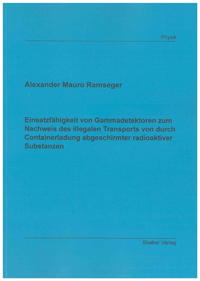
Catalogus : Recensies
Recensies

|
Alexander Mauro Ramseger Einsatzfähigkeit von Gammadetektoren zum Nachweis des illegalen Transports von durch Containerladung abgeschirmter radioaktiver Substanzen ISBN: 978-3-8440-0294-2 Prijs: 45,80 € / 91,60 SFR |
|---|---|
| The topic of this research project is the detection of illicit trafficking of radioactive material inside of cargo containers. The currently used radiation portal monitors (RPM) at border crossings are not sufficient due to two effects which often occur during operation: false positive and false negative alarms. In case of false positive an alarm is given in the absence of radioactive material (or natural and harmless radioactive substances are classified as relevant anthropogenic material). In the second case, false negative, radioactive material with high risk potential is not detected. Because of these two effects, more advanced detections systems and other technical efforts are desirable. The expected increase of cargo container flow and special security programs like the Mega Port Initiative are demanding more reliable detection systems. Main focus of research project: This research project focuses on the applicability of spectrometric gamma detection systems in general. Regardless whether currently used, advanced detectors or hypothetic gamma detectors, all need a certain amount of gamma radiation to afford the identification of characteristic peaks. The overall problem is that the emitted gamma radiation is attenuated and has to be discriminated from the radiation background. One has to consider that the attenuation of radiation depends on the energy, and that often in the lower part of the energetic spectrum a higher background occurs. This leads in particular to a larger decrease of detection probability of radionuclides in the lower part of the energy spectrum. One can assume that even with high ambitioned efforts only a small progress in detection efficiency will be achieved because the marginal improvements approach physical limitations that cannot be overcome. The first part of the research project consisted of measurements with portal monitors and, in comparison, smaller spectrometric detectors. This was done in order to get an overview on realistic measurement conditions on frequently occurring radioactive substances and on minimal detectable activities. The second part is a simulation of portal monitors for gamma radiation. This is done to simulate gamma spectra of radionuclides inside cargo containers transported through a portal monitor. Measurements: Measurements were conducted at the cargo container checkpoint of the German Customs Office at the Hamburg Harbor. At this checkpoint a radiation portal monitor (RTM 910, produced by Mirion Technologies) has been installed. The RTM 910 is capable of neutron and gamma detection with a low energy-resolution. To detect the gamma radiation plastic scintillators are used. The RTM 910 has detectors on both sides of an incoming street to the checkpoint. The distance between the two detector parts is six meters and the cargo containers are transported through this portal monitor with an average velocity of 30 km/h. In the field experiment 30 to 40 cargo containers were controlled per hour. In this time approximately three alarms per hour were given. To examine what kind of radionuclides caused these alarms, it was necessary to analyze spectra of the radiation when such an alarm occurred. For the identification of the radioactive substances two other gamma detectors were used in addition to the RTM 910. One detector (ReGeM, produced by Canberra) was a high-purity-germanium detector with an energy resolution of less than 2 keV (e.g. 0,3% at 662 keV). The other detector (Spir Ident, produced by Mirion Technologies) is based on sodium-iodide and has an energy resolution of about 10 keV. The idea was to take spectra exactly at the time an alarm was given by the RTM 910 and to identify the alarm causing radionuclides by analyzing the spectra. It was possible to identify radionuclides in the spectra that were simultaneously recorded to RTM 910 alarms. All the detected radionuclides are naturally occurring. Simulations: In order to estimate the physical limitations and the remaining room for improvement of RPM, simulations with MCNP were conducted following the above mentioned measurements under field conditions. The best working detection conditions were determined studying the application of sodium-iodide and plastic scintillators in an RPM. The simulated RPMs were based on plastic scintillators and sodium-iodide. In the scenario certain radionuclides (e.g. Cs-137) were located in cargo containers. The containers were inspected with an RPM. The radiation of the nuclides was attenuated by different types of cargo (3) filled in the containers. These cargo types were derived from statistics of US-American and German ports. Every cargo type is related to a certain amount of cargo containers imported and exported. The radiation background was simulated as well to determine the minimum detectable activities. The room for improvement was evaluated regarding the measurement time and the number of used detectors in relation to a certain amount of sufficiently inspected containers. Since every cargo type is related to a certain percentage of imported and exported cargo containers, the room for improvement can be estimated related to a certain amount of containers which are inspected sufficiently. Most of this work was conducted during a research term at the Lawrence Livermore National Laboratory. (orig.) | |
| Bron: Energy Technology Data Exchange (ETDE) : DE11FF082 | |
| verder naar publicatie ... | |